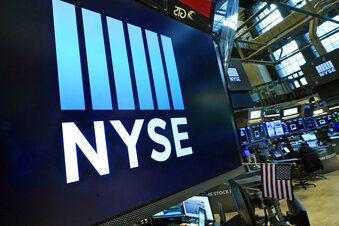Wall Street opens lower following pullback in retail sales
4 min read
FILE - Logos the New York Stock Exchange adorn trading posts, on the floor, Wednesday, March 16, 2022. Stocks are off to mixed start on Wall Street, Thursday, April 7, as several major technology stocks rose even as many other parts of the market were in the red. (AP Photo/Richard Drew, File)
NEW YORK (AP) — Stocks are opening lower across the board on Wall Street as traders grapple with a sharp pullback in retail spending last month and new signals from the Federal Reserve that interest rates will need to go higher than previously expected. The S&P 500 was down 1.4% in the early going Thursday, erasing nearly all of its gains from early in the week. The tech-heavy Nasdaq composite was off 1.7% and the Dow was down 1.3%. The government reported that retail sales fell 0.6% from October to November, more than expected. The pullback followed a sharp rise the previous month.
THIS IS A BREAKING NEWS UPDATE. AP’s earlier story follows below.
Wall Street was poised to open with losses again on Thursday, one day after a retreat by investors dismayed over the Federal Reserve’s warning that still more interest rate hikes are in store following its latest increase.
Futures for the S&P 500 were down 0.9% and futures for the Dow Jones Industrial Average tumbled 0.7%.
The declines followed the U.S. Federal Reserve’s hike in its key short-term rate by half a percentage point, the seventh increase this year. The Bank of England raised its main lending rate by a half-point Thursday morning and the European Central Bank is expected to follow suit later Thursday with a similar increase.
The U.S. will release Thursday its weekly report on unemployment benefits, along with retail sales data for November. U.S. consumer spending and employment remain strong, hindering the Fed’s fight against inflation, but helping protect the slowing economy from a possible recession.
The U.S. central bank’s increase in its key short-term rate by 0.50 percentage points Wednesday was expected. What spooked investors was Fed officials saying they expects rates to climb higher in coming years than previously anticipated.
“The Fed did not welcome the disinflation trends that have just started to emerge and focused on robust job gains and elevated inflation,” Edward Moya of Oanda said in a commentary. “Any hopes of a soft landing disappeared as the Fed seems like they are committed to taking rates much higher.”
Wednesday’s hike was smaller than the previous four 0.75 percentage point increases and takes the federal funds rate to a range of 4.25% to 4.5%, the highest level in 15 years. It followed an encouraging report showing that inflation in the U.S. slowed in November for a fifth straight month, to 7.1%.
Fed policymakers forecast that the central bank’s rate will reach a range of 5% to 5.25% by the end of 2023.
Recent signs that inflation has eased had stoked optimism that the Fed might signal the possibility of rate cuts in the second half of next year. But Fed Chair Jerome Powell emphasized that the full effects of the central bank’s efforts to slow the economy to bring down inflation have yet to be fully felt.
The Fed plans to hold rates at a level high enough to slow the economy “for some time” to ensure inflation really is crushed. Projections released Wednesday did not include any rate cuts in 2023.
“I wouldn’t see the committee cutting rates until we’re confident that inflation is moving down in a sustained way,” Powell said.
The Fed did signal it expects its rate to fall to 4.1% by the end of 2024 and 3.1% by late 2025.
In Europe, Germany’s DAX sank 1.2%, as did the CAC 40 in Paris. Britain’s FTSE 100 slipped 0.5%.
Japan reported its trade deficit surged to over 2 trillion yen ($15 billion) in November as higher costs for oil and a weak yen combined to push imports higher. It was the 16th straight month of red ink and a record high for the month of November.
Also Thursday, the Asian Development Bank downgraded its forecasts for developing economies in Asia, putting growth for the region at 4.2% this year and 4.6% in 2023. The earlier forecasts had put 2022 growth at 4.3% and 2023’s expansion at 4.9%.
The update forecast a 3% expansion for China, the world’s second-largest economy, in 2022, with growth in 2023 expected to rise to 4.3% as stringent pandemic restrictions are eased.
In Asian trading, Tokyo’s Nikkei 225 lost 0.4% to 28,051.70 and the Hang Seng in Hong Kong sank 1.6% to 19,368.59. The Kospi in Seoul gave up 1.6% to 2,360.97.
The Shanghai Composite index gave back 0.3% to close at 3,168.65 and Australia’s S&P/ASX 200 shed 0.6% to 7,204.80.
Shares fell in Taiwan and Bangkok but rose in Mumbai.
In other trading Thursday, U.S. benchmark crude gave up 3 cents to $77.31 per barrel in electronic trading on the New York Mercantile Exchange. It gained $1.89 to $77.28 a barrel on Wednesday.
Brent crude, the pricing basis for international trading, also fell 3 cents, to $82.73 per barrel.
The U.S. dollar rose to 136.49 Japanese yen from 135.46 yen. The euro fell to $1.0622 from $1.0682.
On Wednesday, the S&P 500 lost 0.6% and the Dow industrials shed 0.4%. The Nasdaq composite gave back 0.8% while the Russell 2000 index lost 0.7%.






